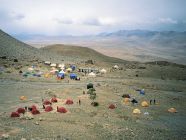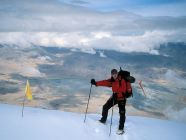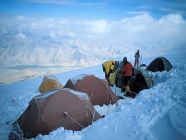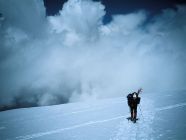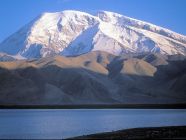This is the report that I wrote for Jagged Globe about the 2003 expedition that I led to Muztag Ata. This was my third expedition to this peak following a ski ascent that I made in 1998 and a return visit in 2002.
Jagged Globe Muztag Ata 2003
Travel difficulties in Central Asia and the SARS problem in China have substantially reduced the number of foreign tourists travelling to Western China this year. However there were over 150 European climbers attempting 7,546m Muztag Ata during July and August. Almost half of the total number were from France and there were also large groups from Spain, Italy, Germany and Austria. The only English speaking team was the 6-man Jagged Globe group which included members from Australia and Norway.
The mountain is not technically difficult and the main challenges arise from the altitude and the weather. This is an area without a developed system of local porters and expeditions must carry their own equipment on the mountain. Managing the load carrying issue can often mark the difference between a successful expedition and a failure. Donkey transport is available between base camp (4,400m) and camp one (5,400m), but beyond this, team members must do all the work.
This area of Chinese Central Asia has a very low annual rainfall, with most of the precipitation falling as snow in the summer months at high altitudes. This proved to be the case in summer 2003 with the weather conditions not being ideal for climbers. There was very little snowfall during July and the lower slopes of Muztag Ata were very icy when the Jagged Globe team arrived in Base Camp on Aug 7th. During their 18 day stay, there were plenty of clear sunny days, but these were outnumbered by days when quite a bit of snow fell on the mountain. In other years, this could have proved quite a challenge, but this year there were enough climbers (plus a large Chinese scientific group) to keep the trail between camps open even after 20 - 30cm of new snow had fallen.
Some of the teams on the mountain used skis as much as possible while others chose to use crampons lower down and snowshoes higher up. Similarly, some opted to spend a great deal of time above base camp to aid acclimatisation while others prefered to spend more time in base camp and make shorter forrays onto the peak. The Jagged Globe team chose to use the latter tactic with some modification for those who initially showed signs of acclimatising slowly.
Camp one (54,00m) was stocked with 200kg of supplies carried by donkeys from base camp on Aug 9th. Team members spent 2 nights (Aug 11 & 12) sleeping at Camp one and carried loads to camp two (6,100m) on Aug 12th before returning to BC for a few days rest. The summit push began on Aug 16th when all 6 members of the team climbed to camp one. The following day they asended to camp two and then onto camp 3 (6,800m) on the 18th. All 6 members reached camp 3 and spent a somewhat cold and breathless night at this high altitude camp overlooking the Pamir mountains of Tajikistan and Kirgyzstan.
The following morning all set out for the summit. However, this was not to be the 100% success that the team had hoped for. The ascent to camp 3 the previous day had been more tiring than expected and had taken a lot out of the team members. Combined with the discomfort of a night at 6,800m, this caused 4 of the group to retire within the first hour of setting out. One had cold hands as a result of inadequate gloves, one had cold feet from poor quality boots and 2 others felt insufficiently rested and fed to face the long pull to the summit. This group of 4 returned to camp 3 and rested throughout the day. The expedition leader together with a Norwegian member continued to the summit in changable weather, arriving at 14.10, about five and a half hours after leaving camp 3.
The Jagged Globe team was one of very few groups who managed to get all the expedition members sleeping in camp 3 at the same time. All team members reached a height of over 7000m. Although there was undoubtedly an element of disappointment that more members did not reach the summit, the members of the expedition were all pleased to be part of a tight-knit team that had achieved much and all felt that they had learnt much from their own personal performances. Climbing conditions throughout August were far from perfect and many large teams on Muztag Ata failed to put a single member on the summit. Seen from this perspective,2 out of 6 on the summit with the others reaching 7000m is a very creditable result.
David Hamilton, Kashgar 26 August 2003


